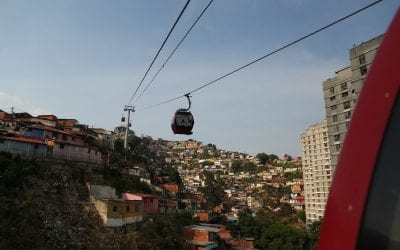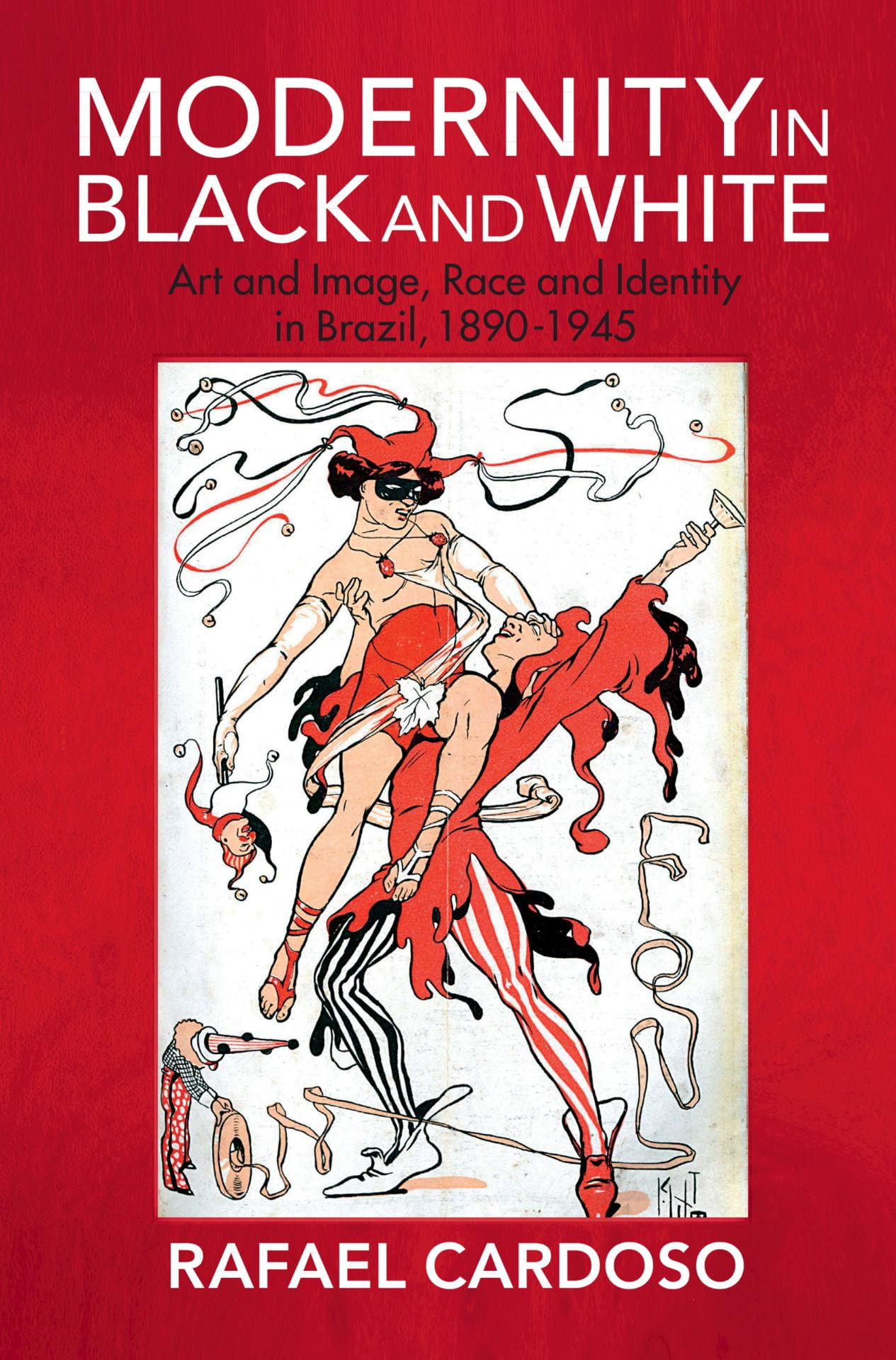Transportation Itself Does Not Build Urban Structures
Talking in the barrio
Fina Rojas lives in the 19 de Abril at Petare, the densest and one of the largest self-produced neighborhoods in Latin America. Most researchers and policymakers define self-produced neighborhoods as “informal settlements.” However, these settlements occur from infinite and often hidden human agreements that include formal, informal and other activities, allowing an effective building of some infrastructure, especially housing. That is why I have decided to adopt the concept of self-produced neighborhoods.

Self-Produced Neighborhood Petare (Caracas) – Foto: Ignacio Cardona // BARRIO AUTOPPRODUCIDO PETARE (CARACAS) – PHOTO: IGNACIO CARDONA.
Actually, Fina Rojas is a pseudonym. She is a community activist working amid Venezuela’s fragile political situation, which is why she has asked me to hide her identity. Since 2004, Fina and I have worked together in more than 20 Participatory Design Workshops to discuss urban issues with other community members; and this text is a summary of some discussions that we decided to have on urban transportation.
“In San Agustín, the government built a cable car like in Medellín,” she tells me. “It would be fantastic to have one of these in 19 de Abril.” I fully understand Fina’s concern. The daily journey from her home to the nearest subway station takes more than 90 minutes to walk through winding streets, even though the geographical distance is only 600 meters (2,000 feet), less than 10 north-south New York City blocks. Another way to get to the subway is through trunk routes known as jeeps; the only transportation system made up of 9 to 12-seat traction vehicles, as a community reaction to the government’s inability to provide better transportation systems.
“Don’t you think a cablecar would work better than the jeeps? Then, we would no longer have to travel the little streets of the neighborhood,” asks Fina. Afterward, Fina and I began a long and always enriching discussion on urban issues. This time we talked about cable cars—the Metrocables, as we have decided to call these public transportation systems in many places in Latin America; we spoke about Santo Domingo Savio in Medellín and San Agustín in Caracas, only 12 kilometers (7.46 miles) away from Fina’s house
Participatory Design Workshops that we organize usually involve long talks where people come and go in a mixture of festivity and academy. We argue for hours, days or weeks —because we often keep the same topic discussed from one meeting to the next one. In these workshops, I look for my academic files in Zotero, we call or chat by WhatsApp to many people, including other community members and experts on the field, and—it must be said—Google Search is a fundamental vehicle of information.
This time we conclude that transportation is a necessary but not sufficient infrastructure. The way we move and enjoy the city occurs in the structure of its human and spatial relationships. Urban infrastructure is just a support of these relations.
“Of course, dear architect, the prefix infra means underneath,” Fina jokes with me. “So the infrastructure is below the structure.”
Indeed, the infrastructure is just a support to the urban structure. Without the urban—and human—structuring of relationships that takes place in the urban fabric, transportation infrastructure is meaningless. No urban infrastructure, not even the one for transportation, builds urban relationships by itself. Comparing Santo Domingo Savio in Medellin and San Agustín in Caracas allows us to put these conclusions in evidence.
Santo Domingo Savio
Medellín is a world-renowned innovative city thanks to its transportation infrastructure. When Sergio Fajardo became mayor in 2004, he found the Metrocables project already in progress; his team created Comprehensive Urban Plans (Planes Urbanos Integrales) to overlay this infrastructure on other layers of the urban structure.
In 2016, I had the opportunity to talk several times with Alejandro Echeverri, director of Medellin’s Urban Development Company (Empresa de Desarrollo Urbano), between 2004 and 2008. After pleasant chats supported by beer or coffee, we concluded at least three variables that made possible the experience of Medellín. First, the synergy between political will and academic capability facilitates the application of academic design experiments in the field. Second, the entrepreneurial culture of the paisa—the local inhabitant of Medellín—, which has historically permeated all levels of society, allowing a social agreement in favor of the urban transformation. Third, the gradual overcoming of violence since the 1991 death of drug trafficker Pablo Escobar, which included pacts with armed gangs for crime reduction, as well as the capacity of public space to build community resilience. Thus, Medellín’s success dwells in multidimensional factors beyond the internet-spread images of physical interventions.
In Medellín, one of the most emblematic transformation cases around the Metrocable’s Line K connected to Acevedo, one of the most important mass transit stations that runs north-south through the city. The system runs 2.07 km (1.29 miles) through three stations through the self-produced neighborhood—Andalucía, Popular, and Santo Domingo Savio. The images of Medellín’s Metrocable crossing the sky of self-produced streets and houses have become an example of social inclusion.
This transport infrastructure brings people to different facilities within the neighborhood, including the world-famous parques-biblioteca (library-parks) and smaller-scale local facilities, including public spaces such as plazas and playgrounds. According to Italian urban planner Bernardo Secchi (2001), the combination of lines, points and surfaces at different scales is an effective tool for urban planning. Following the Medellin scheme, transportation as a line, and facilities as activation points, have served as a recipe for imagining urban interventions on the surface of the self-produced neighborhood.
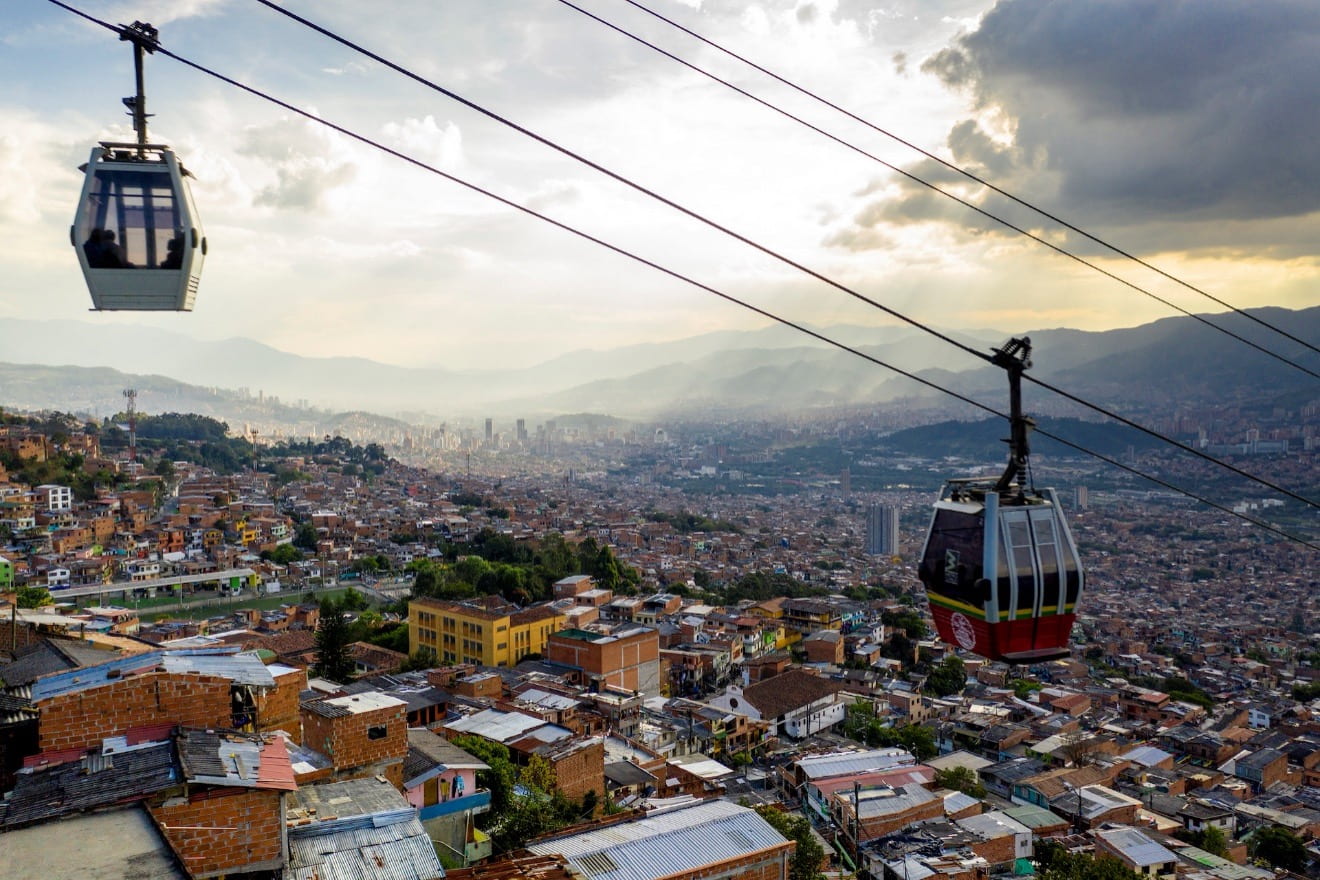
METROCABLE OF SANTO DOMINGO SAVIO (MEDELLÍN) – FOTO: PRIZEFORCITIES.ORG. // METROCABLE DE SANTO DOMINGO SAVIO (MEDELLÍN) – PHOTO: PRIZEFORCITIES.ORG
The powerful image of Metrocables soaring through the air of the self-produced city has become a supposed silver bullet for a positive urban transformation. In addition to the Metrocables of Medellin and Caracas, today we have TransMiCable in Bogota, Mi Teleférico in La Paz and Cali, Mexicable in Ecatepec, the Teleférico do Alemão in Rio de Janeiro, among others. Yet, each of these cases is different and deserves a special tour, not only under their cables but also through their real capacities for urban integration.
During our extended conversation, Fina and I got in touch with Jorge Blandón, who leads the communitarian cultural group Nuestra Gente, located in the K line’s neighborhoods. With passion, Jorge speaks about the urban physical structure—streets, bridges, and playgrounds—that connect different neighborhood points. All of them were built or refurbished within the framework of the Comprehensive Urban Plan led by the local government. Jorge forgets to talk about Metrocables, even though transportation is our initial question. Cablecars are nothing but a way to get to what is important: the street where cultural activities occur.
We must remember that Metrocable’s Line K in Medellin runs through three urban sectors: Andalucía, Popular and Santo Domingo. In Andalucía, Jorge highlights the bridges at Carrera 48a; the Mirador Bridge to the north brings you closer to Comuna 2, and the La Paz Bridge to the south with a lovely tree in the middle of the path. I personally remember the joy of seeing the idea of the bridge materialize beyond walkability to a place to stay and contemplate. When talking about Andalucía, Jorge gets emotional when explaining the impact of the local Casa de Justicia and the community newspaper Mi Comuna 2 as the real milestones of the neighborhood.
In Popular, Jorge talks about his participation in the first urban art gallery painted on the party-walls of the houses. The Medellín project was a co-production of local governments and community participation. This experience is a glimpse that shows inclusive development through the articulation of normative needs and the intelligent efficacy of local self-production. For us, it is fortunate to have Jorge’s narrative since he is a fundamental actor in the transformation of Medellín from a community platform.
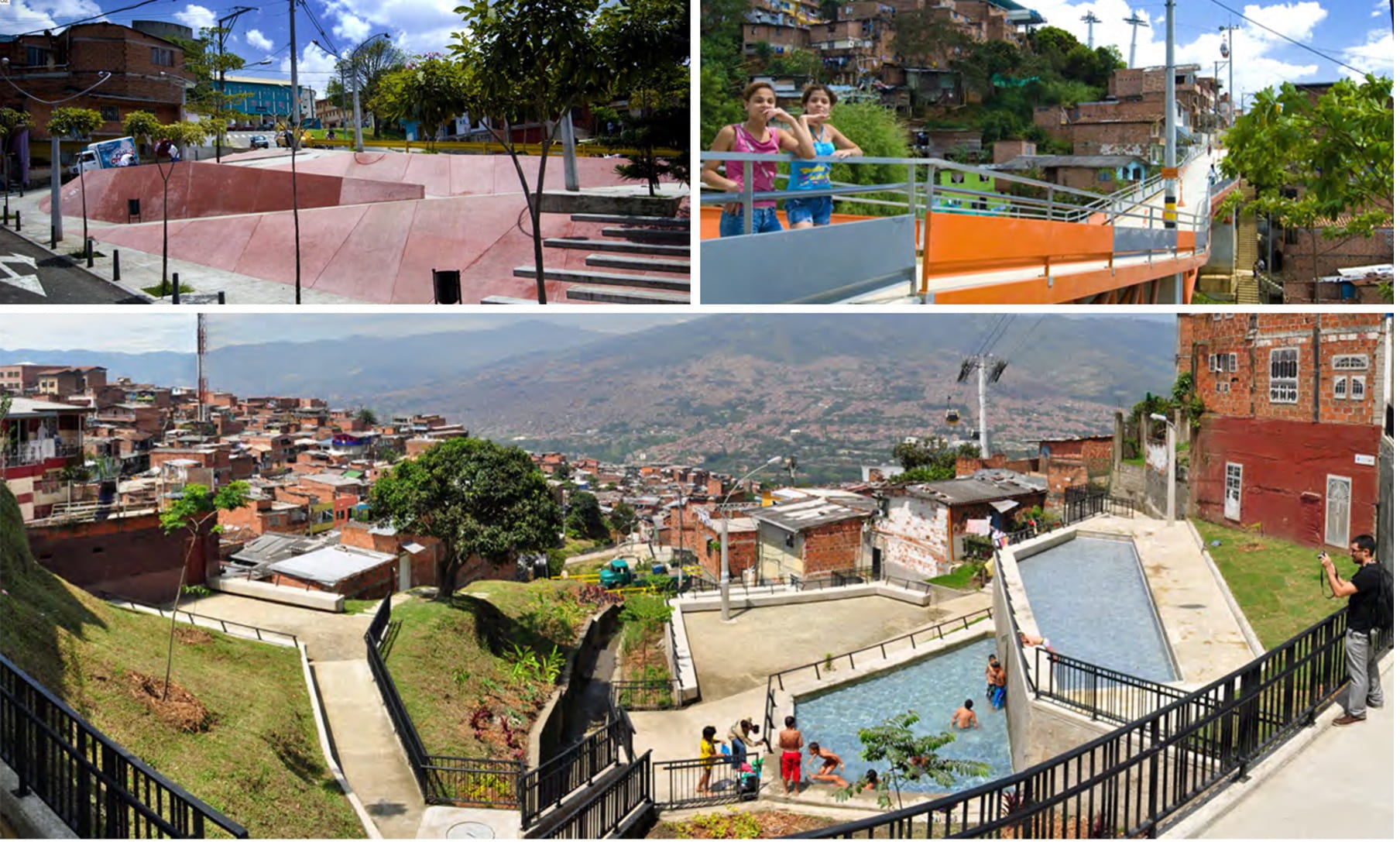
PUBLIC SPACES AROUND LINE K’S METROCABLE – IMAGES: EDU (2004-2007) // ESPACIOS PÚBLICS EN TORNO A LA LÍNEA K DEL METROCABLE – IMÁGENES: EDU (2004-2007)
Jorge ends his spoken tour with the arrival of the Metrocable to Santo Domingo Savio, where the widest sidewalks made it possible to walk towards Parque-Biblioteca España. Jorge vehemently complains about the building’s current state of deterioration. However, he emphasizes that the Talleres de los Abuelos (the senior citizens’ workshops) that used to take place there now meets in a small community center in the neighborhood. Happily, the project included systems of sidewalks to reach different areas beyond the Parque-Biblioteca España.
Following Jorge’s talk, we confirm that the most relevant in the Medellín project is the urban structure built through systems of multi-scale connections. Human relations of an integrated and integrating city occur in the urban structure of multiple connections in which transportation is one of many infrastructural systems.
Several weeks ago, when I met with June Carolyn Erlick, editor of ReVista, the Harvard Review of Latin America, to discuss this article, she asked me about the difference between transportation and mobility. Here I cannot describe the case of Medellín without thinking about the mobility that allows the structure of spaces and routes connected to each other. Transportation occurs in different layers—the cablecars, the pedestrian routes, street transportation, etc.—and they are intertwined with other infrastructures built at different scales, including the parques-biblioteca (library-parks) and the little house where a woman sells empanadas.
I think all this while Jorge continues talking passionately about the system of community relationships in Medellín. These are the same relationships that Fina works on daily, even though she has a less urban structure to develop them.
San Agustín
Walking through 19 de Abril is tiring; nobody designed the street to walk. Therefore, the San Agustín Metrocable has become a reference point for Fina and her neighbors. This system was completed in December 2009, in the midst of one of the most significant economic booms in the history of an oil-producing country, when the price of oil reaches $167.30 a barrel. Some researchers and policymakers are confused in equating San Agustín with the system that ends in Santo Domingo Savio. Certainly, both transportation systems are similar, but the case of San Agustín lacked the construction of a system of public spaces that would contribute to articulating the precarious urban structure of this sector of the city.
San Agustín is an agglomeration that includes an affordable housing neighborhood, built in 1928 by the urban developers Nucete Sardi and Roche on flatlands at the southern foothills of the Central Valley of Caracas. The urban complex continues with self-produced neighborhoods built on sloping land called San Agustín and San Pedro. Then, the urban system connects with a middle-income community Colinas de Las Acacias, reaching the Avenida Presidente Medina, one of southwest Caracas’ most important avenues.
Globally, self-produced neighborhoods tend to be located on the outskirts of urban centers, but this is not the case of San Agustín, located in the geographic center of the Caracas Valley with significant levels of connectivity both in the lower part of the slope—to the north— and in the upper part —to the south. Nevertheless, the self-produced neighborhood has been historically efficient in housing construction, although limited in consolidating infrastructure, such as street networks. Because of this, the steepest zones in San Agustín have limited possibilities of getting from one place to another.
As we travel along the main Caracas highway at the edge of San Agustín, Metrocable surprises us by crossing from side to side, connecting the neighborhood with the Parque Central Metro station. As in Medellín, Parque Central is one of the most important mass transit stations that runs east-west through Caracas. The Metrocable departs from this station, following 1.80 km (1.18 miles) through four stations. The first three cablecar stations are located at the top of the self-produced neighborhood—Hornos de Cal, La Ceiba and El Manguito—, and next to the street system that ends at Avenida Presidente Medina; the system goes back down to the north, in the central valley of Caracas, reaching the San Agustín station.
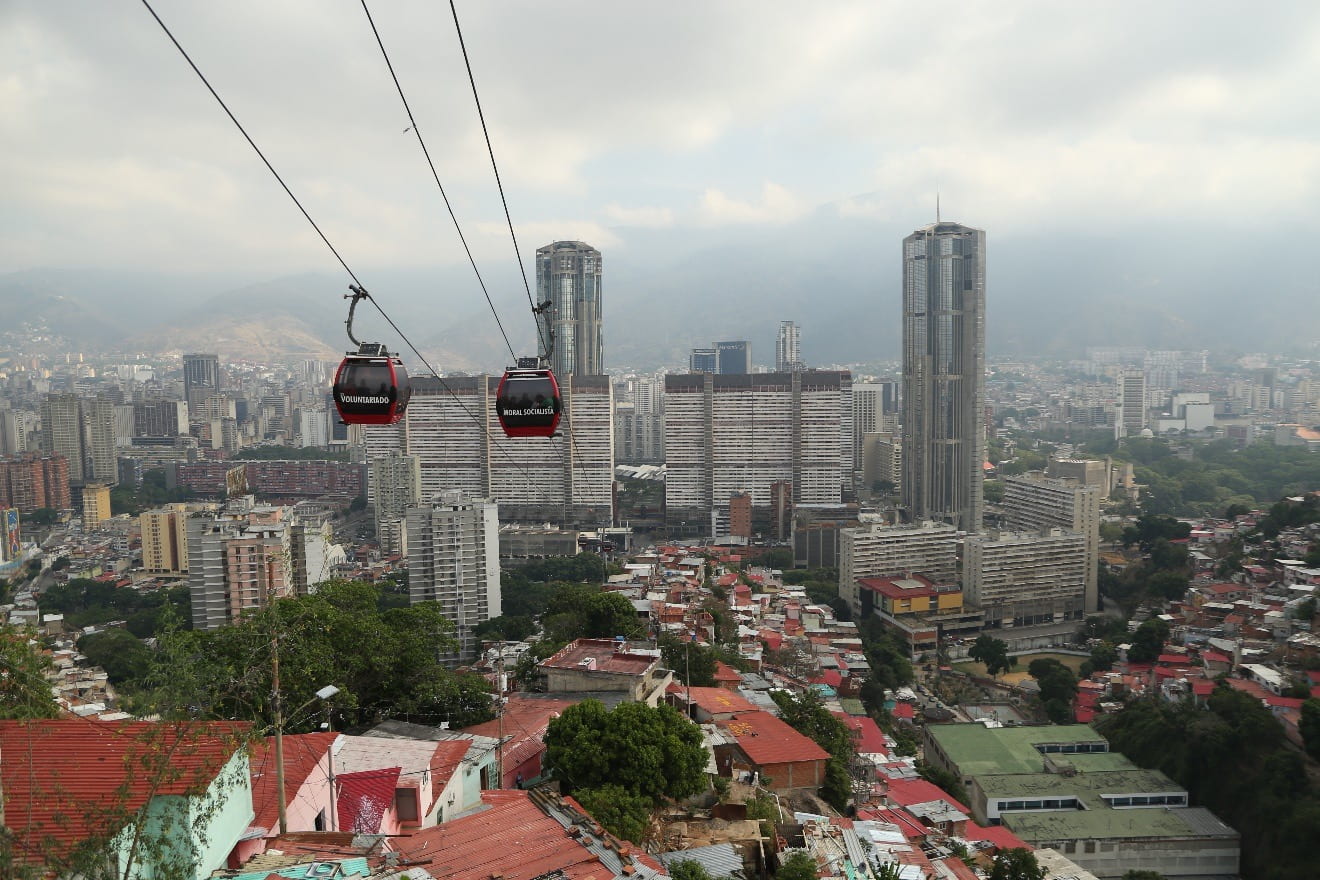
METROCABLE OF SAN AGUSTÍN (CARACAS) NORTH VIEW – PHOTO: RICARDO HERDENEZ. // METROCABLE DE SAN AGUSTÍN (CARACAS) VISTA NORTE – FOTO: RICARDO HERDENEZ.
The beauty of this transportation infrastructure is undeniable. Additionally, the cablecars’ cabins have inscriptions with words such as libertad, igualdad y equidad (freedom, equality and equity) to express the democratic values that represent their function of social inclusion. From streets and alleys of the neighborhood, but also from other parts of the city, the landscape impresses with the splendor of the valley, the powerful image of the houses of San Agustín built from decades of self-production, and the technology of the transportation system; all of that construct a photo that deserves thousands of likes in any of the social networks.
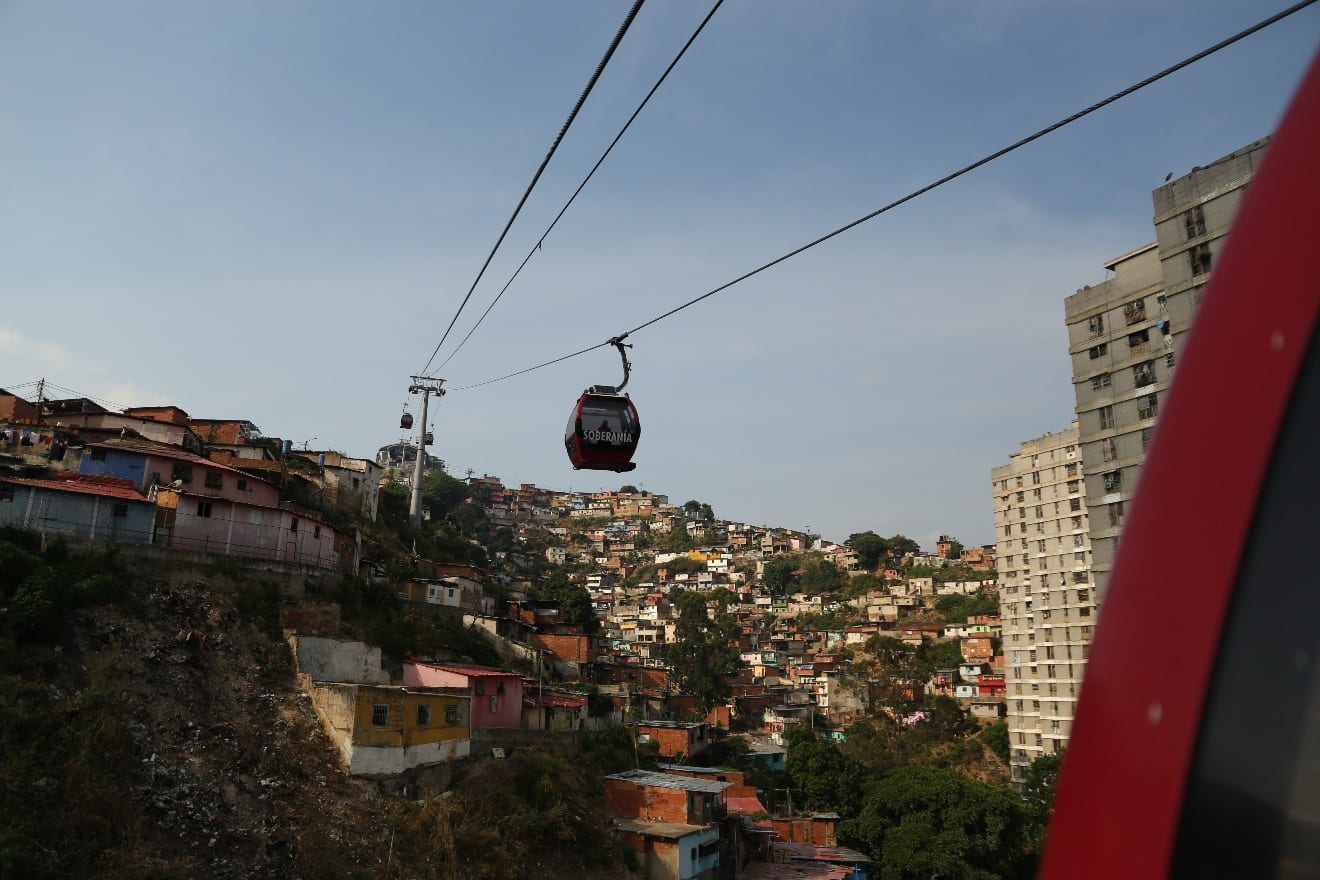
METROCABLE OF SAN AGUSTÍN (CARACAS) SOUTH VIEW – PHOTO: RICARDO HERDENEZ. // METROCABLE DE SAN AGUSTÍN (CARACAS) VISTA SUR – FOTO: RICARDO HERDENEZ.
The residents of San Agustín and its advocates are smart, and they are aware of the power of this image. Taking photos from the viewpoint of the Hornos de Cal station—the only public space built as part of the Metrocable project—has become one of the hot spots for visitors taking the San Agustín’s CumbeTour, a community-run tourist project to enjoy the beauty of the neighborhood, especially its powerful Afro-Venezuelan musical tradition.
Seeking to understand more about San Agustín’s Metrocable experience, Fina and I contacted Anil Ramakrishna, an urban planner and professor of Roads and Transportation at Simón Bolívar University. His account is relevant not only because of his knowledge of the subject but also because he had the opportunity to work in San Agustín for a state institution studying the impacts of the Metrocable before, during, and after its construction. Anil tells us how in 2013, in one of his travels in the cabins of the already built San Agustín Metrocable, a resident said to him that the system did not always satisfy all her daily trips. After interviewing some users and residents of San Agustín, he highlights that many difficulties of accessibility still exist within the neighborhood.
To understand the impact of the Metrocable in San Agustín, I decided to run a Spatial Opportunities analysis, comparing the situation before and after the Metrocable (see below). The Spatial Opportunity Index (SOi) is a tool to measure spatial proximities and connectivities that I developed at Harvard Graduate School of Design. The analysis reflects what is perceived when trying to walk across the neighborhood; this cablecar system has a powerful impact on the image of inclusion while limited in the actual transformation of the mobility systems.
The maps (see below) show that accessibility changed minimally before and after constructing the transportation system. The blue color shows those dwellings with good opportunities to connect spatially to transport stations (SOi ~ 1), while the red color shows those with low accessibility (SOi ~ 0). Presumably, transportation systems should provide a service where there is none; however, we see that the accessibility to the transportation stops in San Agustín is maintained with minimal variations between the situations before and after the construction of the system.
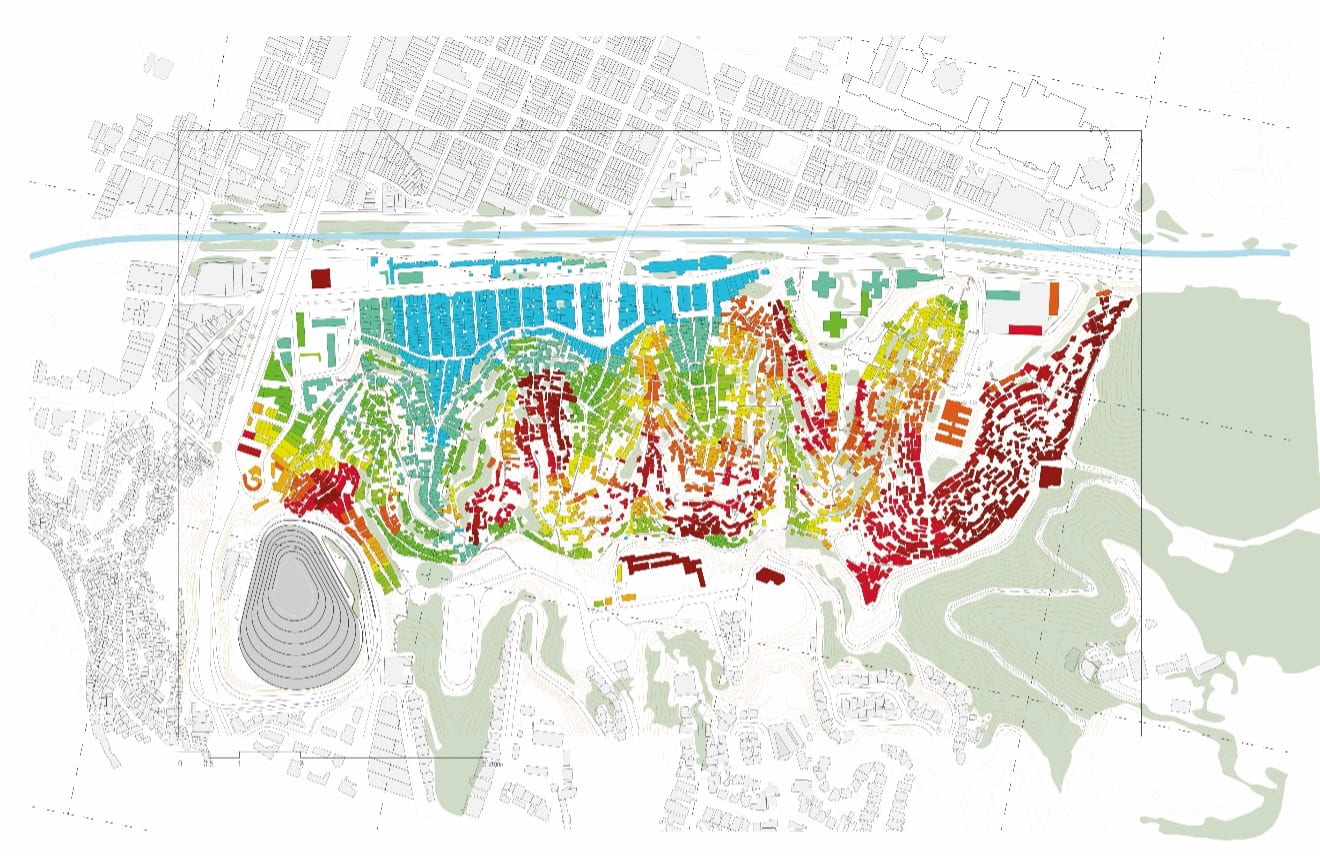
ACCESIBILITY (SOI) IN SAN AGUSTÍN (BEFORE METROCABLE) // ACCESIBILIDAD (SOI) EN SAN AGUSTÍN (ANTES DEL METROCABLE)
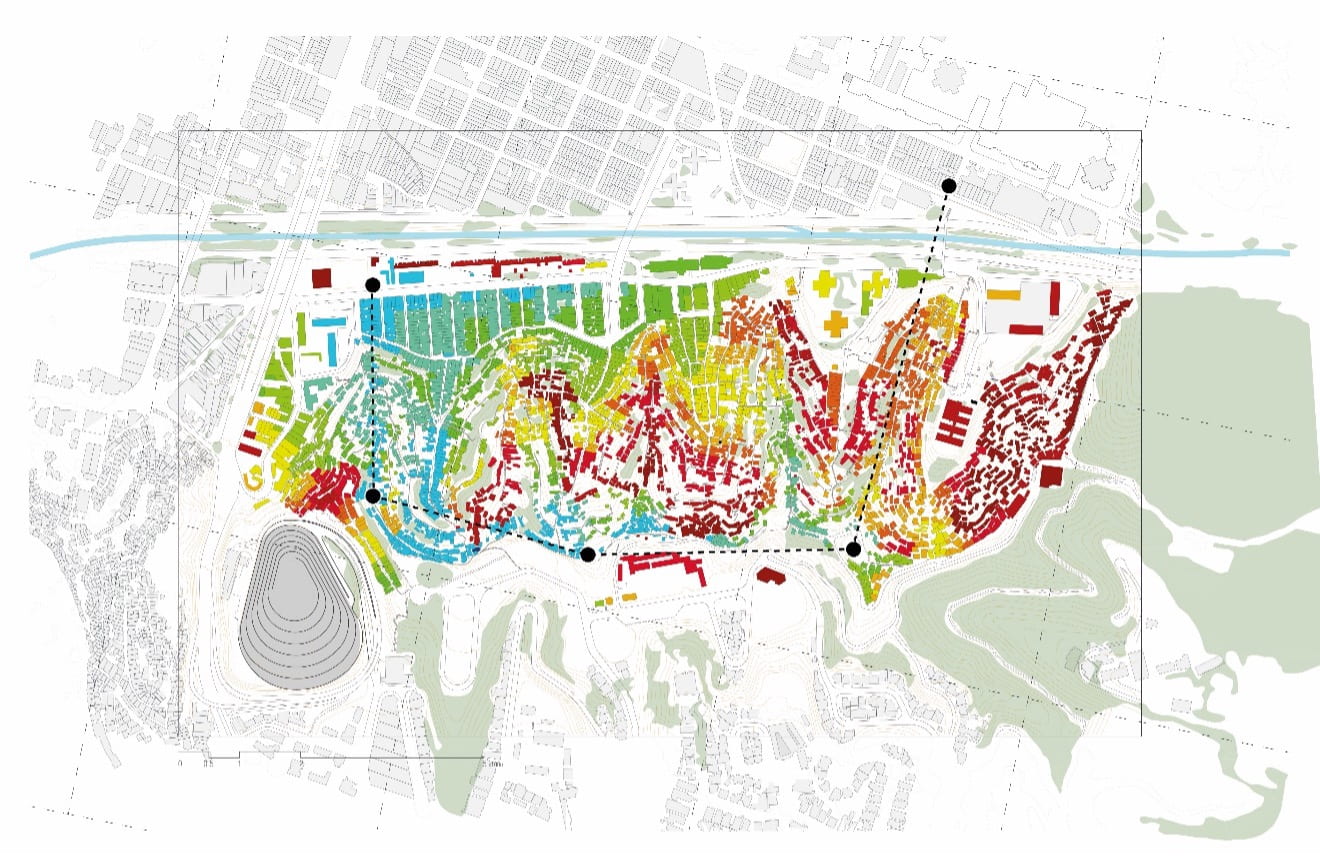
ACCESIBILITY (SOI) IN SAN AGUSTÍN (AFTER METROCABLE) // ACCESIBILIDAD (SOI) EN SAN AGUSTÍN (DESPUÉS DEL METROCABLE)
At the level of infrastructure design, the cause of this incipient improvement in accessibility is evident. The stations were built in well-connected areas but left the self-produced territories disconnected in the middle of the hill. Although mobility improved slightly with the Metrocable, San Agustín’s areas where accessibility is still much better through the trunk system that spans the winding streets.
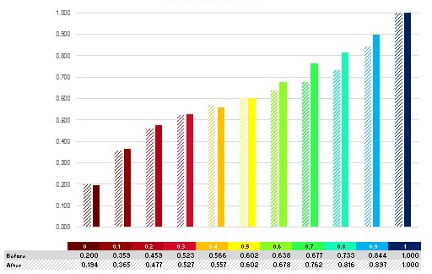
COMPARATIVE TABLE (SOI) – BEFORE AND AFTER OF METROCABLE // CUADRO COMPARATIVO (SOI) – ANTES Y DESPUÉS DEL METROCABLE
Anil Ramakrishna explains that the technical transportation reports stated that the Metrocable was not a viable project. Initial studies showed that there were not enough users to justify the cost of building the system. But the symbolic effect of the image of inclusive transportation especially viewed from the highway, was enough to justify the project. As a result, the project did not include the construction of public spaces because the plan discouraged other modes of transport—such as pedestrian mobility—, which could reduce the number of users on the cable cars. In other words, San Agustín is a transportation-only project and not a structurally urban one.
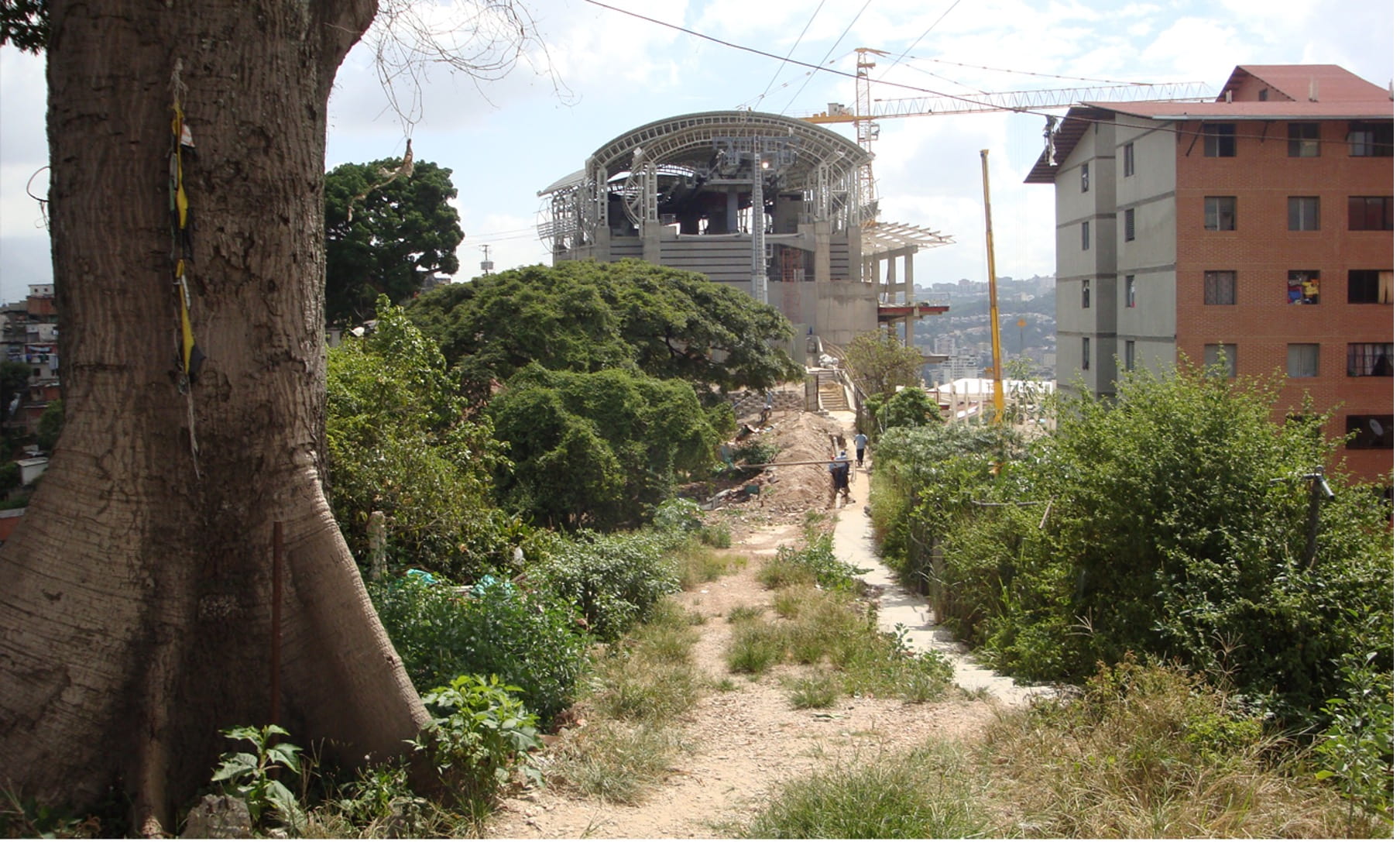
SAN AGUSTÍN AND ITS LACK OF PUBLIC SPACES IN 2010 – PHOTO: SILVIA SOONET // SAN AGUSTÍN Y SU CARENCIA DE ESPACIOS PÚBLICOS EN 2010 – FOTO: SILVIA SOONETS.
We talked with Jesus Paicosa, community leader of the Coordinadora La Calle es de Los Niños (The Street is for Children) of San Agustín, and defender of the neighborhood’s values. While he welcomes the arrival of the Metrocable, he also recognizes that much remains to be done, especially in the difficulties of daily walking and service infrastructures – such as water, electricity, and walkability – at the street level. In the end, the street allows the overlapping of multiple infrastructures, in addition to transportation.
But despite the shortcomings of the San Agustin Metrocable to build a comprehensive urban structure, its community always shows a resilient intelligence. The privileged location of San Agustín and the beauty of the cable car as infrastructure has become an attraction for the Cumbetours. However, this infrastructure is not the main attraction, but rather their residents’ cultural—especially musical musical tradition. Few places blend urban culture and physical space as powerfully as this place. In San Agustín, the mina, the quitiplás, and the culoepuya, instruments of the catchy Afro-Venezuelan music, continue to be one of its most powerful community assets.
Today, San Agustín is a powerful example of urban culture based on the strength of community activation. The Fundación 100% San Agustín has been progressively turning the neighborhood into a cultural symbol that takes advantage of music to build on a strategic plan that includes revitalizing public space. The community members understand that the structure of urban and human relations creates the symbolic value of San Agustín.
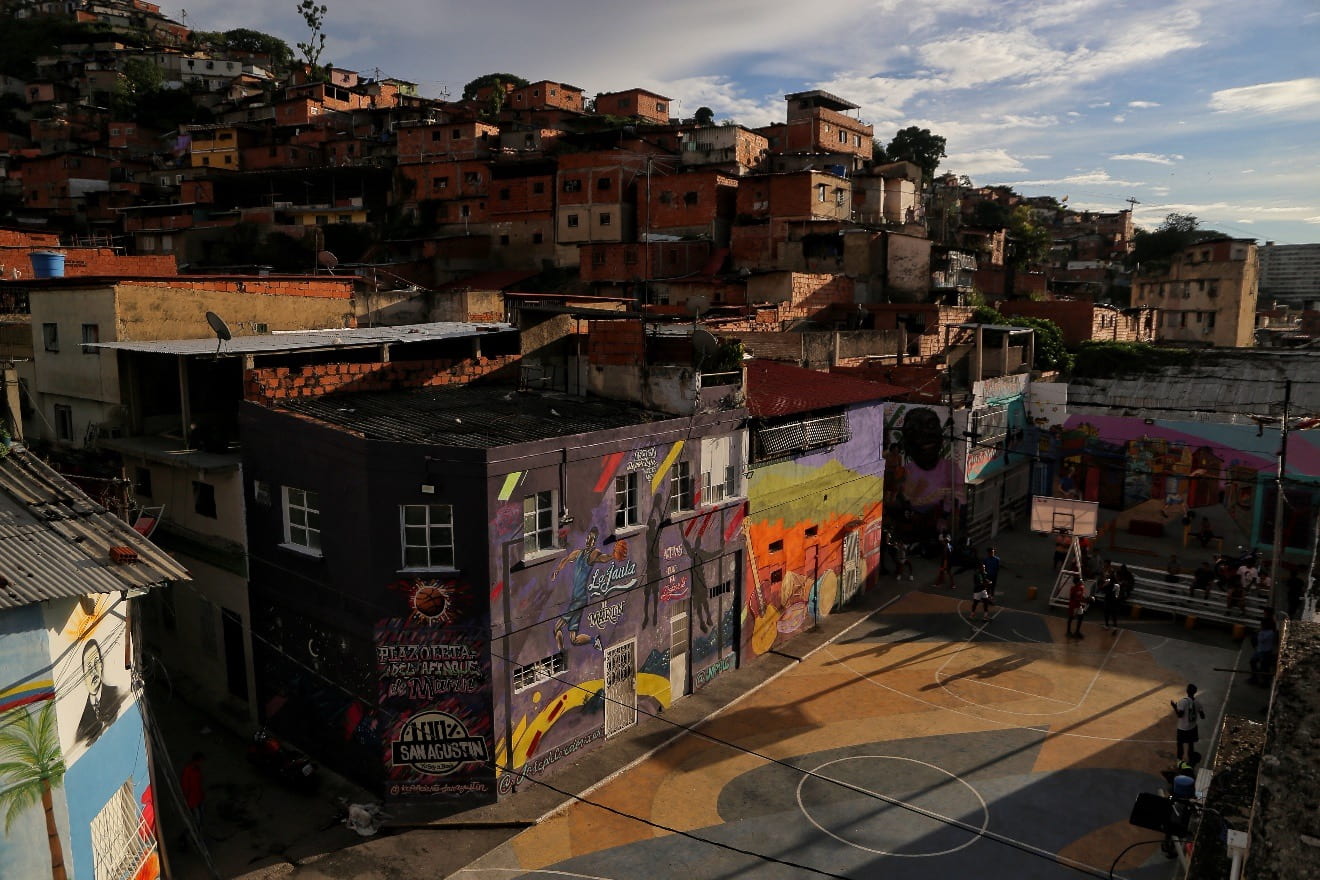
GUAGUACÓ DE COLORES PROJECT – SAN AGUSTÍN (CARACAS) – PHOTO: RICARDO HERDENEZ. // PROYECTO GUAGUANCÓ DE COLORES, SAN AGUSTÍN – FOTO: RICARDO HERDENEZ.
Recently, the Caracas Mayor’s Office supported the renovation of the Plazoleta de Marín, in a fascinating project led by the community called Guaguancó de Colores that mixes art, music and entrepreneurship. This little plaza is next to the Alameda Theater, built by the central government in 1944 and situated in the lower part of the neighborhood to the east of the affordable housing development built in 1928. It is a theater that was closed for almost 40 years, but the community recovered it for community cultural activities in 2004.
Additionally, Jorge Paicosa tells us that the most significant cultural events occur in the Plaza Ruiz Pineda, designed by a team led by architect Manuel Delgado and built between 1986 and 1992 under the coordination of the state institution Centro Simon Bolivar. The community cultural activities that take place today in these spaces are worthy of celebration and joy.
It is no longer a surprise that the two cultural activities that residents celebrate as the most relevant are located within the urban structure away from the Metrocable. The human relations that build cultural tradition find a place in the pre-existing structure, outside the self-produced urbanization whose urban relations the Metrocable project neglected and which are left waiting for a plan that integrates urban systems.
See you later, Fina
A little more than seven miles away, in the Petare neighborhood of 19 de Abril, Fina hears about the beauty of the cultural intensity in Santo Domingo Savio and San Agustín. But Petare does not have the proximity of an urban structure like San Agustín, nor has it had an urban integration project like Santo Domingo Savio. Hopefully, if the government or any other institution of power comes to her neighborhood, it will consider that opportunities also dwell in its little streets. Hopefully, a future project will understand that transportation itself does not build urban structures.
El transporte por sí solo no construye estructuras urbanas
Conversando en el barrio
Por Ignacio Cardona
Fina Rojas vive en la comunidad 19 de Abril de Petare, el barrio autoproducido mas denso y uno de los mas grandes de America Latina. La mayoría de los investigadores y promotores de políticas públicas llaman “asentamientos informales” a los barrios autoproducidos. Sin embargo, este tipo de asentamientos ocurren a partir de infinitos y con frecuencia ocultos acuerdos que incluyen relaciones formales, informales, entre otras, permitiendo una efectiva construcción de algunas infraestructuras, especialmente la vivienda. Por eso he decidido adoptar el concepto de barrios autoproducidos.

Self-Produced Neighborhood Petare (Caracas) – Foto: Ignacio Cardona // BARRIO AUTOPPRODUCIDO PETARE (CARACAS) – PHOTO: IGNACIO CARDONA.
En realidad, Fina Rojas es un seudónimo. Ella es una activista comunitaria que trabaja en medio de la frágil situación política de Venezuela, por lo que me ha pedido que oculte su identidad. Desde 2004, Fina y yo hemos trabajado juntos en más de 20 Talleres de Diseño Participativo para debatir cuestiones urbanas con otros miembros de la comunidad; y este texto es un resumen de algunas discusiones que decidimos tener sobre transporte urbano.
“En San Agustín el gobierno construyó un teleférico como en Medellín”, me dice. “Sería fantástico tener uno de estos en 19 de Abril.” Entiendo perfectamente la preocupación de Fina. El trayecto diario desde su casa hasta la estación de metro más cercana lleva más de 90 minutos caminando por calles sinuosas, aunque la distancia geográfica sea de apenas 600 metros. Otra forma de hacer este recorrido es a través de las rutas troncales conocidas como “los jeeps”, que es el único sistema de transporte formado por vehículos de tracción de 9 a 12 puestos, operados por miembros de la comunidad como reacción a la incapacidad de los gobiernos de proveer transporte público.
“¿No crees que un cablecar funcionaría mejor que los jeeps? Así, ya no tendríamos que recorrer las callecitas del barrio”, me pregunta Fina. A partir de allí, nosotros iniciamos una larga y siempre enriquecedora discusión sobre temas urbanos. Esta vez hablamos de los teleféricos—los Metrocables, como hemos decidido llamar a estos sistemas de transporte público en muchos lugares de América Latina; hablamos de Santo Domingo Savio en Medellín y de San Agustín en Caracas, solamente 12 kilómetros de distancia de la casa de Fina.
Los Talleres de Diseño Participativo que organizamos comúnmente vienen con largas charlas que suelen ser una mezcla de fiesta y academia en la que la gente va y viene. Discutimos durante horas, días o semanas, en las que una reunión sigue a la otra—porque a menudo mantenemos el mismo tema entre las reuniónes. En estos talleres, suelo buscar en mis archivos académicos en Zotero, llamamos o chateamos por WhatsApp con otras personas incluidos otros miembros de la comunidad y expertos en la materia, y—hay que decirlo—las búsquedas en Google se convierten en un vehículo fundamental de información.
Esta vez concluimos que el transporte es una infraestructura necesaria, pero no suficiente. La forma en que nos movemos y disfrutamos de la ciudad se produce en la estructura de sus relaciones humanas y espaciales. La infraestructura urbana es sólo un soporte de estas relaciones.
“Por supuesto, querido arquitecto, el prefijo infra significa debajo”, bromea Fina. “La infraestructura está por debajo de la estructura.”
Ciertamente, la infraestructura es sólo un soporte de la estructura urbana. Sin la estructuración urbana—y humana—de relaciones que tiene lugar en el tejido urbano, la infraestructura de transporte no tiene sentido. Ninguna infraestructura urbana, ni siquiera la de transporte, construye relaciones urbanas por sí misma. La comparación entre Santo Domingo Savio en Medellín, y San Agustín en Caracas a nos permite poner en evidencia estas conclusiones.
Santo Domingo Savio
Medellín se ha convertido en una ciudad de renombre mundial por su carácter innovador, en buena parte debido a sus infraestructuras de transporte. Cuando Sergio Fajardo llegó a la alcaldía en 2004, se encontró con el proyecto de los Metrocables ya en marcha, y su equipo creó Planes Urbanos Integrales para superponer estas infraestructuras a otras capas de la estructura urbana.
En 2016 tuve la oportunidad de conversar varias veces con Alejandro Echeverri, director de la Empresa de Desarrollo Urbano de Medellín entre 2004 y 2008. Tras agradables charlas apoyadas por cerveza o café, concluimos al menos tres variables que hicieron posible la experiencia de Medellín. En primer lugar, la sinergia entre la voluntad política y la capacidad académica, que facilitó la aplicación de los experimentos de diseño académico sobre el hecho construido. En segundo lugar, la cultura emprendedora del paisa—el habitante local de Medellín—que históricamente ha permeado todos los niveles de la sociedad, permitiendo un acuerdo social a favor de la transformación urbana. En tercer lugar, la superación gradual de la violencia desde la muerte de traficante de drogas Pablo Escobar en 1991, que incluyó pactos tanto de bandas armadas para la reducción de la delincuencia, así como la capacidad del espacio público para la construcción de resiliencia comunitaria. Así, el éxito de Medellín reside en factores multidimensionales que van más allá de lo que dicen las imágenes ampliamente difundidas en internet de las itnervenciones físicas.
En Medellín, uno de los casos más emblemáticos de esta transformación en torno a la Línea K del Metrocable conectada con Acevedo, una de las estaciones de transporte masivo más importantes que recorre la ciudad en sentido norte-sur. El sistema recorre 2,07 km a través de tres estaciones que atraviesan el barrio autoproducido—Andalucía, Popular y Santo Domingo Savio. Las imágenes del Metrocable de Medellín cruzando el cielo de calles y casas autoproducidas se han convertido en un ejemplo de inclusión social.
Esta infraestructura de transporte lleva a la gente a diferentes equipamientos dentro del barrio, incluyendo los mundialmente conocidos Parques Biblioteca, pero también equipamientos locales de menor escala incluyendo espacios públicos como plazas y parques infantiles. Según urbanista italiano Bernardo Secchi (2001), la combinación entre líneas, puntos y superficies a diferentes escalas es una herramienta eficaz para la planificación urbana. Siguiente el esquema de Medellín, el transporte como línea, y los equipamientos como puntos de activación, han servido como receta para imaginar intervenciones urbanas sobre la superficie del barrio autoproducido.

METROCABLE OF SANTO DOMINGO SAVIO (MEDELLÍN) – FOTO: PRIZEFORCITIES.ORG. // METROCABLE DE SANTO DOMINGO SAVIO (MEDELLÍN) – PHOTO: PRIZEFORCITIES.ORG
La poderosa imagen de los Metrocables surcando el aire de la ciudad autoproducida se ha convertido en una supuesta receta mágica para una transformación urbana positiva. Además de los Metrocables de Medellín y Caracas, hoy tenemos TransMiCable en Bogotá, Mi Teleférico en La Paz y Cali, Mexicable en Ecatepec, el Teleférico do Alemão en Río de Janeiro, entre otros. Cada uno de estos casos es diferente y merece un recorrido particular, no sólo por sus cables, sino por sus capacidades reales de integración urbana.
En ese momento de la conversación, Fina y yo nos pusimos en contacto con Jorge Blandón, que dirige el grupo cultural comunitario Nuestra Gente, situado en los barrios donde se construyó la línea K. Con pasión, Jorge habla de la estructura física urbana—calles, puentes y patios—que conectan diferentes puntos del barrio. Todos ellos construidos o refraccionados en el marco del Proyecto Urbano Integral liderado por el gobierno local. Jorge se olvida de hablar de los Metrocables, aunque el transporte es nuestra pregunta inicial. Los Metrocables no son más que una forma de llegar a lo importante: la calle donde se desarrollan las actividades culturales.
Recordemos que la Línea K de Metrocable en Medellín recorre tres sectores urbanos: Andalucía, Popular y Santo Domingo. En Andalucía, Jorge destaca los puentes de la Carrera 48a; el Puente del Mirador al norte que te acerca a la Comuna 2, y el Puente de la Paz al sur con un hermoso árbol en medio del camino. En lo personal, recuerdo la alegría de ver materializada la idea del puente no sólo como lugar de paso, sino también como espacio de estancia y contemplación. Al hablar de Andalucía, Jorge se emociona al explicar el impacto de la Casa de Justicia y el periódico comunitario Mi Comuna 2, como verdaderos hitos del lugar.
En Popular, Jorge habla de su participación en la primera galería de arte urbano pintada en las medianeras de las casas. El proyecto de Medellín fue una coproducción de gobierno local y participación comunitaria. Esta experiencia es una mirada que muestra el desarrollo inclusivo a través de la articulación de las necesidades normativas y la inteligente eficacia de la autoproducción local. Para nosotros es una suerte contar con la narración de Jorge, un actor fundamental en la transformación de Medellín desde una plataforma comunitaria.

PUBLIC SPACES AROUND LINE K’S METROCABLE – IMAGES: EDU (2004-2007) // ESPACIOS PÚBLICS EN TORNO A LA LÍNEA K DEL METROCABLE – IMÁGENES: EDU (2004-2007)
Jorge termina su recorrido hablado con la llegada del Metrocable a Santo Domingo Savio, donde las construcción de aceras [andenes como se dicen en Colombia] más anchas permiten caminar hacia el parque-biblioteca España. Con vehemencia, Jorge se queja del actual estado de deterioro del edificio, aunque destaca que los Talleres de los Abuelos que allí se celebraban se reúnen ahora en un pequeño centro comunitario del barrio. Afortunadamente, el proyecto incluía sistemas de aceras para llegar a diferentes lugares más allá del parque-biblioteca España.
Luego de escuchar a Jorge, podemos confirmar que lo más relevante en el proyecto de Medellín es la estructura urbana construida a través de sistemas de conexiones multi-escalares. Las relaciones humanas de una ciudad integrada e integradora ocurren en la estructura urbana de múltiples conexiones donde el transporte es uno entre otros sistemas infraestructurales.
Hace varias semanas, cuando me reuní con June Carolyn Erlick, editora de ReVista, the Harvard Review of Latin America, para hablar de este artículo, me preguntó sobre la diferencia entre transporte y movilidad. Aquí no puedo describir el caso de Medellín sin pensar en la movilidad que permite la estructura de espacios y rutas conectadas entre sí. El transporte se produce en diferentes capas—los teleféricos, las rutas peatonales y el transporte callejero, etc.—y se entrelazan con otras infraestructuras construidas a diferentes escalas, como los parques-biblioteca, pero también la casita donde una mujer vende empanadas.
Pienso todo esto mientras Jorge sigue hablando con pasión del sistema de relaciones comunitarias en Medellín. Son las mismas relaciones que Fina trabaja a diario, aunque tenga menos estructura urbana para desarrollarlas.
San Agustín
Caminar por 19 de Abril es agotador, nadie ha diseñado la calle para caminar. Por eso, el Metrocable de San Agustín se ha convertido en un punto de referencia para Fina y sus vecinos. Este sistema se terminó de construir en diciembre de 2009, en medio de uno de los auges económicos más importantes de la historia de un país productor de petróleo, cuando el barril del crudo alcanzó 167,30 dólares. Algunos investigadores y promotores de políticas públicas se confunden al equiparar San Agustín con el sistema que termina en Santo Domingo Savio. Ciertamente los sistemas de transporte son similares, pero en el caso de San Agustín faltó la construcción de un sistema de espacios públicos que contribuyera a articularse con la precaria estructura urbana de este sector de la ciudad.
San Agustín está situado al sur del Valle Central de Caracas. Es un conjunto conurbado que incluye un barrio de viviendas de interés social, construido en 1928 por los promotores urbanísticos Nucete Sardi y Roche en las tierras planas al pie de las colinas del sur. El conjunto urbano continúa con los barrios autoproducidos San Agustín y San Pedro, construidos sobre terrenos en pendiente, seguido por el vecindario de ingresos medios llamado Colinas de Las Acacias y luego se conecta con la Avenida Presidente Medina, una de las más importantes del suroeste de Caracas.
Globalmente, los barrios de producción propia tienden a ubicarse en la periferia de los centros urbanos, pero este no es el caso de San Agustín, que se encuentra en el centro geográfico del Valle de Caracas con importantes niveles de conectividad tanto en la parte baja de la ladera—al norte—como en la parte alta—al sur. Sin embargo, la urbanización autoproducida ha sido históricamente eficiente en la construcción de viviendas, aunque limitada en la consolidación de redes de infraestructura, como los sistemas de calles. Por ello, las zonas con mayor pendiente de San Agustín tienen posibilidades limitadas de recorrer de un lugar a otro.
Al transitar por la autopista principal de Caracas a la altura de San Agustín, el Metrocable nos sorprende cruzando de lado a lado conectando el barrio con la estación de Metro Parque Central. Al igual que en Medellín, Parque Central es una de las estaciones de transporte masivo más importantes que recorre Caracas de este a oeste. Desde esta estación parte el Metrocable, que recorre 1,8 km. a través de cuatro estaciones. Las tres primeras ubicadas en la parte alta del barrio autogestionado—Hornos de Cal, La Ceiba y El Manguito—, junto al sistema de calles que termina en la Avenida Presidente Medina; el sistema vuelve a bajar hacia el norte, en el valle central de Caracas, llegando a la estación San Agustín.

METROCABLE OF SAN AGUSTÍN (CARACAS) NORTH VIEW – PHOTO: RICARDO HERDENEZ. // METROCABLE DE SAN AGUSTÍN (CARACAS) VISTA NORTE – FOTO: RICARDO HERDENEZ.
La belleza de esta infraestructura de transporte es innegable, y también quiere mostrarse como un ejemplo de inclusión social. Asimismo, las cabinas del sistema tienen inscripciones con palabras como libertad, igualdad y para expresar los valores democráticos que ejemplifican su función de inclusión social. Desde calles y callejones del barrio, pero también desde otros puntos de la ciudad, el paisaje impresiona por el esplendor del valle, la poderosa imagen de las casas de San Agustín construidas a partir de décadas de autoproducción, y la tecnología del sistema de transporte; todo ello construye una imagen que merece miles de likes en cualquiera de las redes sociales.

METROCABLE OF SAN AGUSTÍN (CARACAS) SOUTH VIEW – PHOTO: RICARDO HERDENEZ. // METROCABLE DE SAN AGUSTÍN (CARACAS) VISTA SUR – FOTO: RICARDO HERDENEZ.
Los vecinos de San Agustín y sus defensores son inteligentes y son conscientes del poder de esta imagen. La toma de fotos desde el mirador de la estación de Hornos de Cal—el único espacio público construido en el marco del proyecto del Metrocable—se ha convertido en uno de los puntos calientes para los visitantes que realizan el CumbeTour en San Agustín, un proyecto turístico de gestión comunitaria para disfrutar de la belleza del barrio, especialmente de su poderosa tradición musical afrovenezolana.
Buscando entender más sobre la experiencia del Metrocable de San Agustín, Fina y yo nos pusimos en contacto con Anil Ramakrishna, urbanista y profesor de Vialidad y Transporte de la Universidad Simón Bolívar. Su relato es relevante no sólo por sus conocimientos sobre el tema, sino porque tuvo la oportunidad de trabajar en San Agustín para una institución estatal que estudiaba los impactos del Metrocable antes, durante y después de su construcción. Anil nos cuenta cómo en 2013, en uno de sus recorridos por las cabinas del ya construido Metrocable de San Agustín, una vecina le comentó que el sistema no siempre satisfacía todos sus desplazamientos diarios. Tras entrevistarse con algunos usuarios y vecinos de San Agustín, destaca que todavía existen muchas dificultades de accesibilidad en el barrio.
Para entender el impacto del Metrocable en San Agustín, decidí realizar un análisis de oportunidades espaciales, comparando la situación antes y después del Metrocable (Ver abajo). El Índice de Oportunidad Espacial (SOi por sus siglas en inglés), es una herramienta para medir proximidades espaciales y conectividades que desarrollé en Harvard Graduate School of Design. El resultado del análisis es similar a lo que se percibe cuando se intenta atravesar el barrio a pie, este sistema de teleférico tiene un poderoso impacto en la imagen de inclusión, mientras que es limitado en la transformación real de los sistemas de movilidad.
Los mapas (ver más abajo) muestran que la accesibilidad cambió mínimamente antes y después de la construcción del sistema de transporte. El color azul muestra aquellas viviendas con buenas oportunidades para conectarse espacialmente a las estaciones de transporte (SOi ~ 1), mientras que el color rojo muestra aquellas con baja accesibilidad (SOi ~ 0). Supuestamente, los sistemas de transporte deberían proporcionar un servicio donde no lo hay; sin embargo, vemos que la accesibilidad a las paradas de transporte en San Agustín se mantiene con variaciones mínimas entre las situaciones antes y después de la construcción del sistema.

ACCESIBILITY (SOI) IN SAN AGUSTÍN (BEFORE METROCABLE) // ACCESIBILIDAD (SOI) EN SAN AGUSTÍN (ANTES DEL METROCABLE)

ACCESIBILITY (SOI) IN SAN AGUSTÍN (AFTER METROCABLE) // ACCESIBILIDAD (SOI) EN SAN AGUSTÍN (DESPUÉS DEL METROCABLE)
A nivel de diseño de la infraestructura, las causas de esta incipiente mejora en los niveles de accesibilidad son evidentes. Las estaciones se construyeron en zonas bien conectadas, pero dejando desconectadas las zonas de producción propia en medio de la colina. Aunque la movilidad mejoró ligeramente con el Metrocable, hay zonas de San Agustín donde la accesibilidad sigue siendo mucho mejor a través del sistema troncal que atraviesa las calles intrincadas.

COMPARATIVE TABLE (SOI) – BEFORE AND AFTER OF METROCABLE // CUADRO COMPARATIVO (SOI) – ANTES Y DESPUÉS DEL METROCABLE
Anil Ramakrishna explica que los informes técnicos de transporte afirmaban que el Metrocable no era un proyecto viable. Los estudios iniciales demostraron que no había suficientes usuarios para justificar el coste de construcción del sistema. Pero el efecto simbólico de la imagen del transporte inclusivo, especialmente visto desde la autopista fue suficiente para justificar el proyecto. En consecuencia, el proyecto no incluyó la construcción de espacios públicos porque el plan desalentaba otros modos de transporte—como la movilidad peatonal, porque podrían reducir el número de usuarios de los teleféricos. En otras palabras, San Agustín es un proyecto sólo de transporte y no uno estructuralmente urbano.

SAN AGUSTÍN AND ITS LACK OF PUBLIC SPACES IN 2010 – PHOTO: SILVIA SOONET // SAN AGUSTÍN Y SU CARENCIA DE ESPACIOS PÚBLICOS EN 2010 – FOTO: SILVIA SOONETS.
Conversamos con Jesús Paicosa, líder comunitario de la Coordinadora La Calle es de Los Niños en San Agustín, y defensor de los valores del barrio. Aunque celebra la llegada del Metrocable, también reconoce que queda mucho por hacer, sobre todo en lo que se refiere a las dificultades de los desplazamientos diarios y las infraestructuras de servicios -como el agua, la electricidad y la transitabilidad- a pie de calle. Al final, la calle permite la superposición de múltiples infraestructuras, además del transporte.
Pero a pesar de las deficiencias del Metrocable de San Agustín para construir una estructura urbana integral, su comunidad siempre muestra una inteligencia resistente y resiliente. La ubicación privilegiada de San Agustín y la belleza del teleférico como infraestructura se ha convertido en un atractivo para los Cumbetours, aunque esta infraestructura no es el principal atractivo, sino la tradición cultural—especialmente de carácter musical—de sus redidentes. Hay pocos lugares que combinen la cultura urbana y el espacio físico con tanta fuerza como esta parroquia. En San Agustín, la mina, el quitiplás y la culoepuya, instrumentos de la pagajosa música afrovenezolana, siguen siendo uno de sus activos comunitarios más potentes.
Hoy en día, San Agustín es un poderoso ejemplo de cultura urbana basada en la fuerza de la activación comunitaria. La Fundación 100% San Agustín ha ido convirtiendo progresivamente el barrio en un símbolo cultural que aprovecha la música para construir un plan estratégico que incluye la revitalización del espacio público. La comunidad entiende que la estructura de las relaciones urbanas y humanas construye el valor simbólico que representa San Agustín.

GUAGUACÓ DE COLORES PROJECT – SAN AGUSTÍN (CARACAS) – PHOTO: RICARDO HERDENEZ. // PROYECTO GUAGUANCÓ DE COLORES, SAN AGUSTÍN – FOTO: RICARDO HERDENEZ.
Recientemente, la Alcaldía de Caracas apoyó la renovación de la Plazoleta de Marín, en un fascinante proyecto liderado por la comunidad denominada Guaguancó de Colores que mezcla arte, música y emprendimiento. Esta pequeña plaza se encuentra junto al Teatro Alameda construido por el gobierno central en 1944 y situado en la parte baja del barrio al este de la urbanización construida en 1928. Se trata de un teatro que estuvo cerrado durante casi 40 años, pero la comunidad lo recuperó para actividades culturales comunitarias en 2004.
Adicionalmente, Jorge Paicosa nos cuenta que los eventos culturales más significativos tienen lugar en la Plaza Ruiz Pineda, diseñada por un equipo dirigido por el arquitecto Manuel Delgado y construida entre 1986 y 1992 bajo la coordinación de la institución estatal Centro Simón Bolívar. Las actividades culturales comunitarias que se dan ho en día en esos espacios son dignos de celebración y alegría.
A estas alturas ya no sorprende que las dos actividades culturales que los vecinos celebran como las más relevantes se ubiquen en las inmediaciones del Teatro Alameda y en la Plaza Ruiz Pineda, en lugares situados en la estructura urbana alejados del Metrocable. Las relaciones humanas que construyen la tradición cultural encuentran su lugar en la estructura preexistente, fuera de la urbanización autoproducida cuyas relaciones urbanas que fueron desconocidas por el proyecto del Metrocable, y que quedan a la espera de un plan que integre las estructuras urbanas.
Hasta pronto, Fina
A doce kilómetros, en el barrio 19 de Abril de Petare, Fina escucha hablar de la belleza de la intensidad cultural de Santo Domingo Savio y San Agustín. Pero Petare no tiene la proximidad de una estructura urbana como San Agustín, ni ha tenido un proyecto de integración urbana como Santo Domingo Savio. Ojalá que si el gobierno o cualquier otra institución de poder llega a su barrio, considere que las oportunidades también habitan en sus intrincadas callecitas. Ojalá un proyecto futuro entienda que el transporte por sí solo no construye estructuras urbanas.
Fall 2021, Volume XXI, Number 1
Ignacio Cardona, a Venezuelan architect and urban designer, holds a Doctor of Design from the Harvard Graduate of Design. He is a Visiting Professor at Wentworth Institute of Technology and the Tecnológico de Monterrey. He is the director of Arepa Architecture Ecology and Participation.
Ignacio Cardona, Doctor en Diseño de Harvard Graduate of Design, es arquitecto y diseñador urbano venezolano. Profesor Visitante en Wentworth Institute of Technology y el Tecnológico de Monterrey, el es Director de Arepa Architecture Ecology and Participation.
Related Articles
Editor’s Letter: Transportation
Bridges. Highways. Tunnels. Buses. Trains. Subways. Transmilenio. Transcable. When I first started working on this issue of ReVista on Transportation (Volume XXI, No. I), I imagined transportation as infrastructure.
Modernity in Black and White
For years, one of my favorite pieces in the Museo de Arte Latinoamericano de Buenos Aires (MALBA) was the iconic Abaporu (1928), by Brazilian artist Tarsila do Amaral: a canvas…
La Güera Rodríguez
By now, history has added a layer to the many ironies that Brandeis historian Silvia Arrom highlights in her spirited book about a controversial historical figure. The recent irony is…

